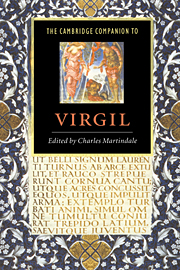Book contents
- Frontmatter
- Contents
- List of illustrations
- List of contributors
- Preface
- 1 Introduction: ‘The classic of all Europe’
- Part 1 Translation and reception
- Part 2 Genre and poetic career
- Part 3 Contexts of production
- 12 Poetry and power: Virgil's poetry in contemporary context
- 13 Rome and its traditions
- 14 Virgil and the cosmos: religious and philosophical ideas
- 15 The Virgilian intertext
- Part 4 Contents and forms
- Dateline compiled by Genevieve Liveley
- List of works cited
- Index
- Plates
13 - Rome and its traditions
from Part 3 - Contexts of production
Published online by Cambridge University Press: 28 May 2006
- Frontmatter
- Contents
- List of illustrations
- List of contributors
- Preface
- 1 Introduction: ‘The classic of all Europe’
- Part 1 Translation and reception
- Part 2 Genre and poetic career
- Part 3 Contexts of production
- 12 Poetry and power: Virgil's poetry in contemporary context
- 13 Rome and its traditions
- 14 Virgil and the cosmos: religious and philosophical ideas
- 15 The Virgilian intertext
- Part 4 Contents and forms
- Dateline compiled by Genevieve Liveley
- List of works cited
- Index
- Plates
Summary
In Book 8 of the Aeneid, when Aeneas visits the Arcadian settlement of Pallanteum, he is led by Evander through the site of the future city of Rome. What greets them is a rustic scene: wooded hills, herds of cattle, a simple village of humble immigrants. As Aeneas' ship comes up the Tiber, the waves themselves marvel at the unfamiliar sight of armed men on an oared ship. Virgil's readers might have reacted similarly to the novelty of the scene, a view of Rome before historical Rome existed: a small settlement surrounded by forest near the banks of a river, occupying the place of the buildings and grandeur of Augustan Rome, with the commerce of the Tiber and of the Forum Boarium where Aeneas landed. As the Trojans arrive, the contrast between past and present is made explicit: they see Evander's small village 'which Roman power has now raised to the heavens' (8.99-100). So too, during Aeneas' walk through the future city, Evander is described as 'the founder of the Roman citadel' (313); they pass the gate 'which the Romans call Carmentalis' (338-9); the Capitoline is 'golden now, once bristling with wooded thickets' (348). As they reach Evander's house, they see herds of cattle 'mooing in the Roman Forum and the fashionable Carinae' (361).
- Type
- Chapter
- Information
- The Cambridge Companion to Virgil , pp. 188 - 203Publisher: Cambridge University PressPrint publication year: 1997
- 28
- Cited by

